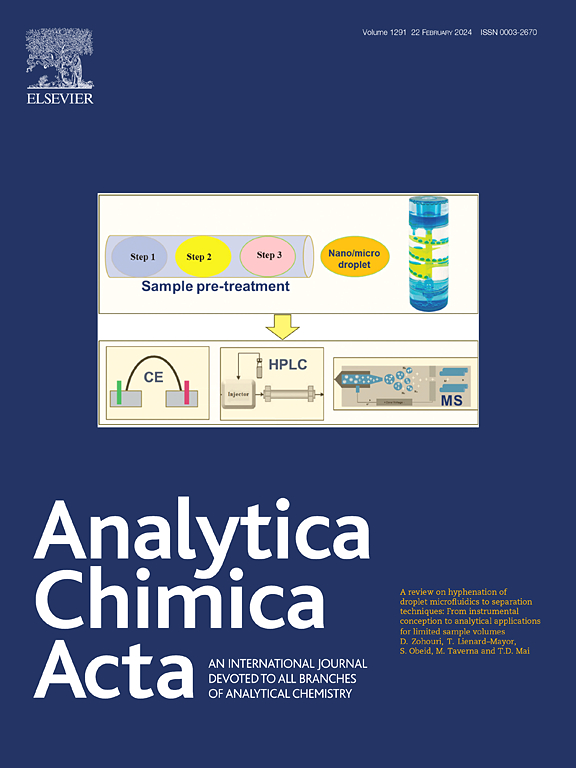结合免疫磁珠与噬菌体溶酶LysGH15进行金黄色葡萄球菌的荧光检测
IF 5.7
2区 化学
Q1 CHEMISTRY, ANALYTICAL
引用次数: 0
摘要
背景金黄色葡萄球菌(金黄色葡萄球菌)是引起食源性疾病的最重要病原体之一。开发早期发现和监测金黄色葡萄球菌的新方法是预防和控制食源性疾病发生的关键。结果本研究将金黄色葡萄球菌噬菌体LysGH15的C54A突变体(LysGH15-C54A)与增强型绿色荧光蛋白(EGFP)融合,构建重组蛋白LysGH15-C54A-EGFP。利用LysGH15-C54A- egfp作为FL信号载体,LysGH15-C54A偶联免疫磁珠(LysGH15-C54A- imbs)作为分离元件和捕获剂检测金色葡萄球菌的荧光检测方案,建立了LysGH15-C54A识别金色葡萄球菌的高特异性和高效率。LysGH15-C54A-IMBs能够特异性分离和捕获金黄色葡萄球菌,利用LysGH15-C54A-EGFP结合捕获的金黄色葡萄球菌表面空位,实现对金黄色葡萄球菌的双位点识别FL检测。当金黄色葡萄球菌在103 ~ 106 CFU/mL的浓度范围内检测时,FL法线性良好,检出限为85 CFU/mL,整个过程持续时间小于1 h。该方法成功应用于鲜奶样品中金黄色葡萄球菌的定量,回收率为93.09% ~ 101.04%。基于以上结果,我们认为基于lysgh15 - c54的FL检测方法具有快速、准确、特异诊断金黄色葡萄球菌的潜力,具有良好的实际应用前景。本文章由计算机程序翻译,如有差异,请以英文原文为准。

Combining immunomagnetic beads and the phage lysin LysGH15 for fluorescence detection of Staphylococcus aureus
Background
Staphylococcus aureus (S. aureus) is one of the most important pathogens that causes foodborne illnesses. The development of new methods for the early detection and surveillance of S. aureus is key to preventing and controlling the occurrence of foodborne diseases.
Results
In this study, the C54A mutation of LysGH15 (LysGH15-C54A) of the S. aureus bacteriophage lysin was fused with enhanced green fluorescent protein (EGFP) to construct the recombinant protein LysGH15-C54A-EGFP. A fluorescence (FL) detection protocol using LysGH15-C54A-EGFP as the FL signal carrier and LysGH15-C54A coupled with immunomagnetic beads (LysGH15-C54A-IMBs) as the isolating element and capturing agent for the detection of S. aureus was established on the basis of the high specificity and efficiency of LysGH15-C54A in recognizing S. aureus. LysGH15-C54A-IMBs were able to specifically separate and capture S. aureus, and LysGH15-C54A-EGFP was used to combine the captured surface vacancies of S. aureus to achieve FL detection of S. aureus using two-site recognition. When S. aureus was detected in the concentration range of 103–106 CFU/mL, the FL method showed good linearity with a detection limit of 85 CFU/mL, and the whole process lasted less than 1 h. The procedure was successfully applied to quantify S. aureus in fresh milk samples, and the recovery values ranged from 93.09 % to 101.04 %.
Significance
Based on these results, we believe that LysGH15-C54A-based FL detection method hold great potential for rapid, accurate, and specific diagnosis of S. aureus, and it has good prospects in practical applications.
求助全文
通过发布文献求助,成功后即可免费获取论文全文。
去求助
来源期刊

Analytica Chimica Acta
化学-分析化学
CiteScore
10.40
自引率
6.50%
发文量
1081
审稿时长
38 days
期刊介绍:
Analytica Chimica Acta has an open access mirror journal Analytica Chimica Acta: X, sharing the same aims and scope, editorial team, submission system and rigorous peer review.
Analytica Chimica Acta provides a forum for the rapid publication of original research, and critical, comprehensive reviews dealing with all aspects of fundamental and applied modern analytical chemistry. The journal welcomes the submission of research papers which report studies concerning the development of new and significant analytical methodologies. In determining the suitability of submitted articles for publication, particular scrutiny will be placed on the degree of novelty and impact of the research and the extent to which it adds to the existing body of knowledge in analytical chemistry.
 求助内容:
求助内容: 应助结果提醒方式:
应助结果提醒方式:


